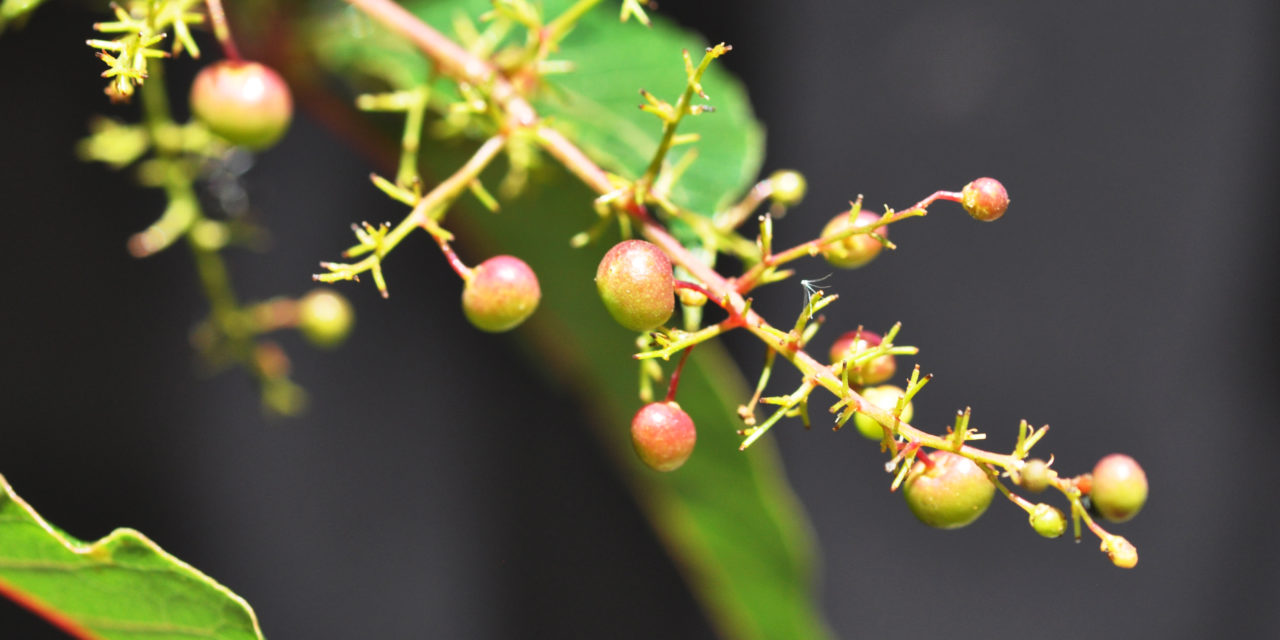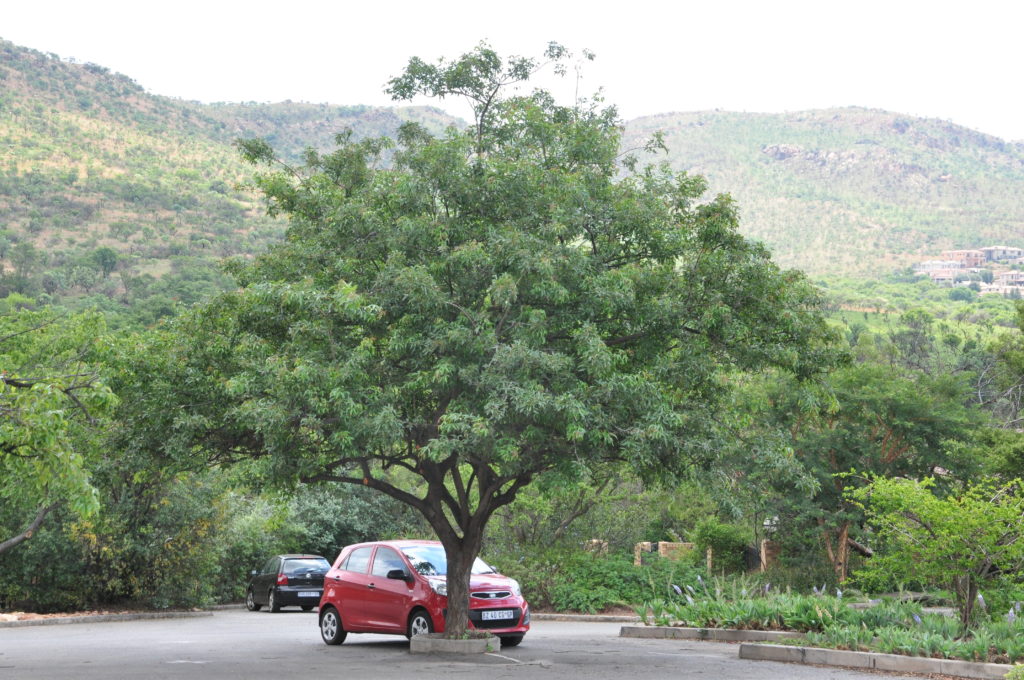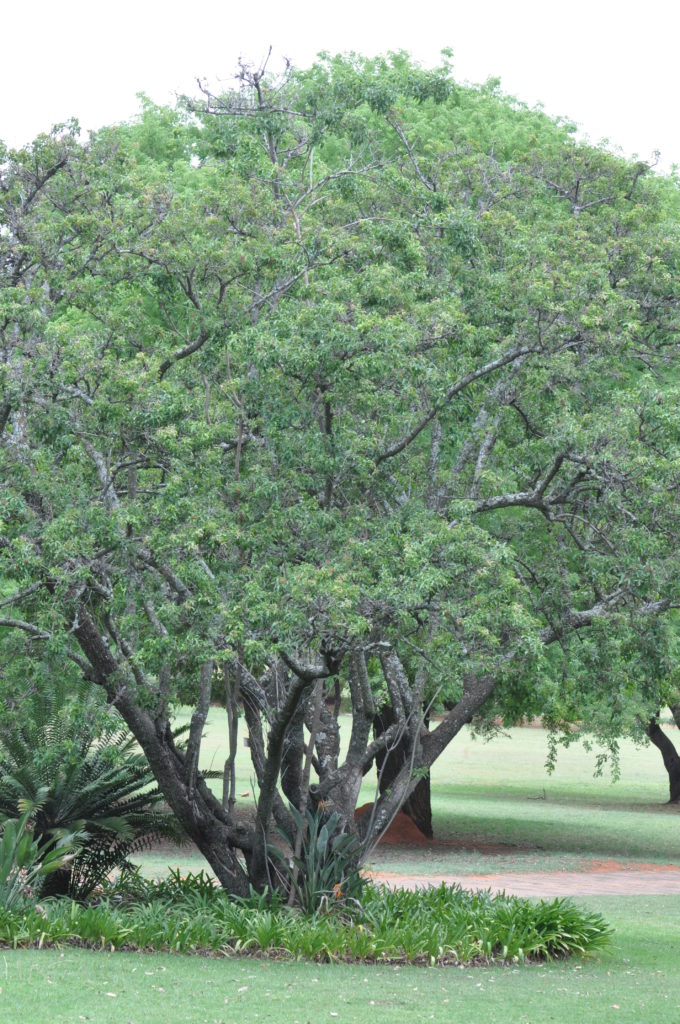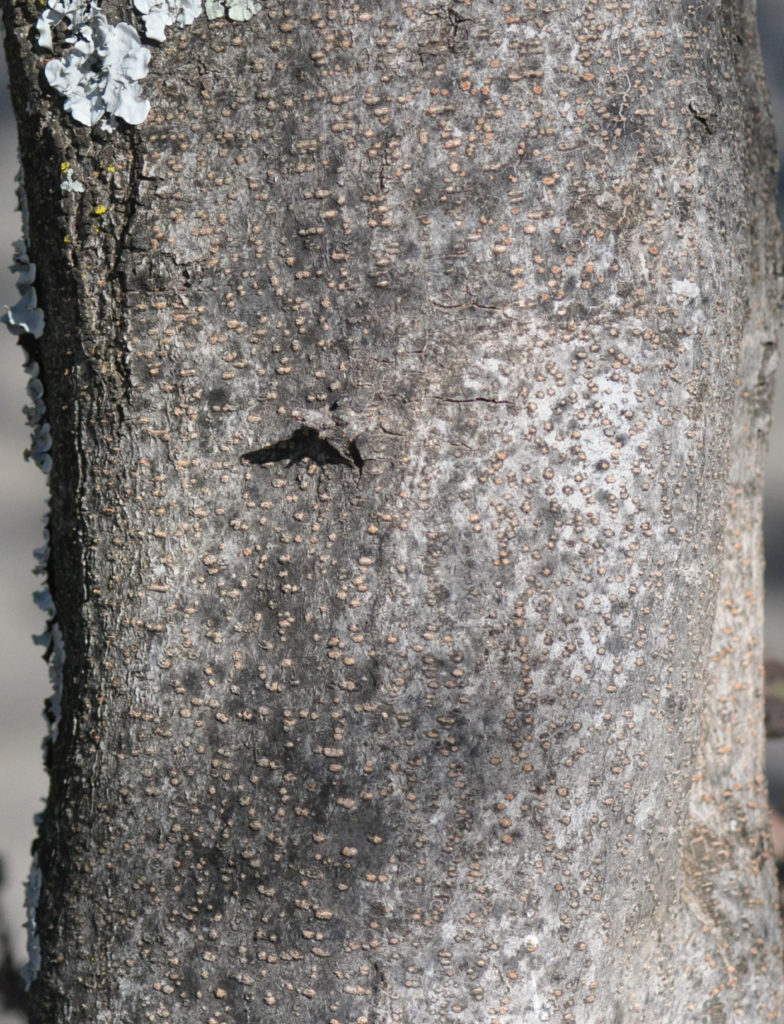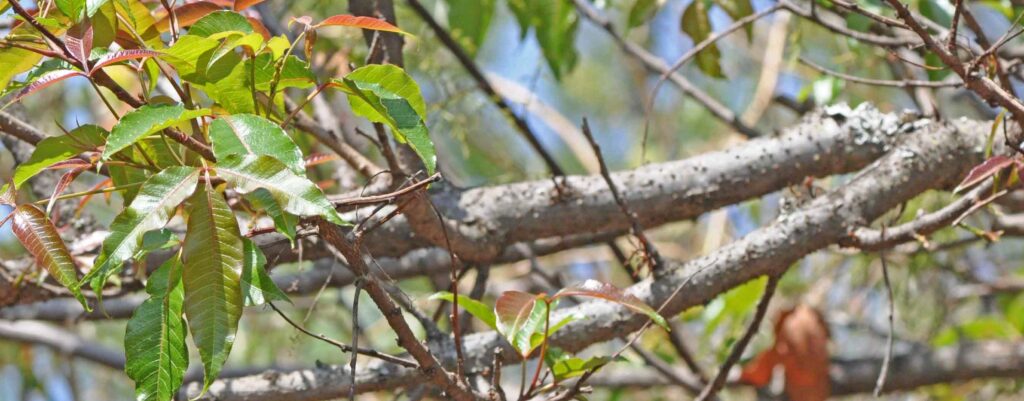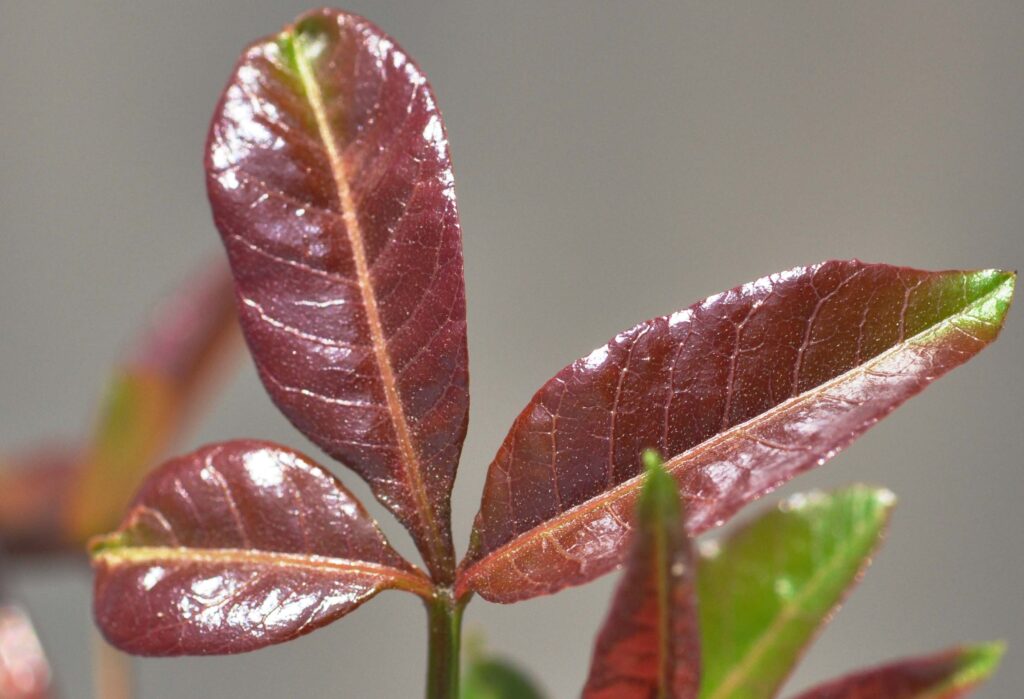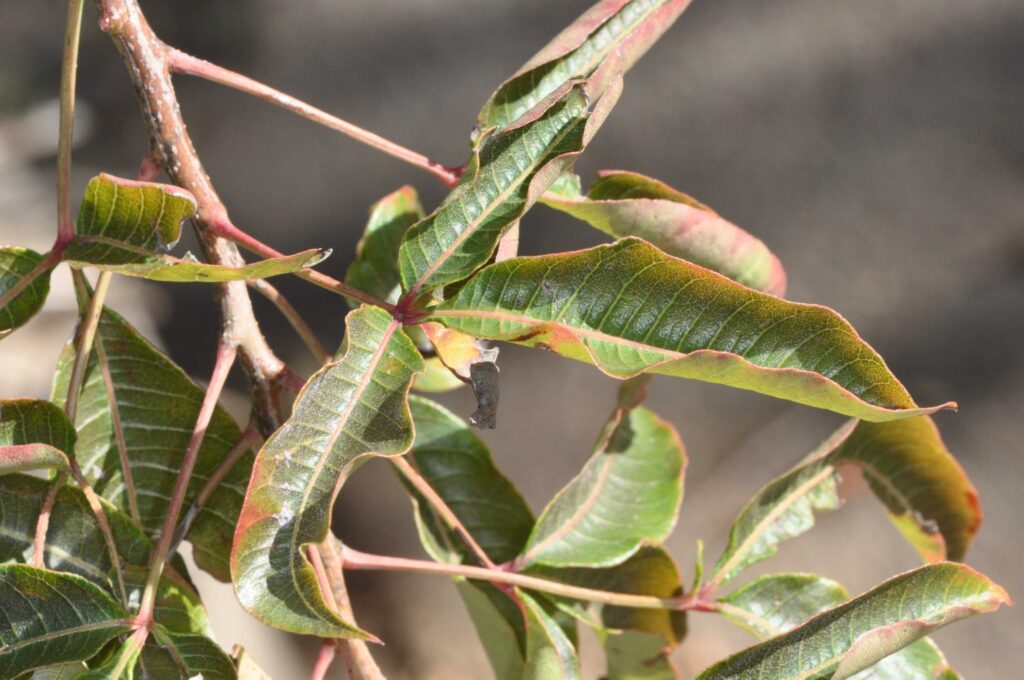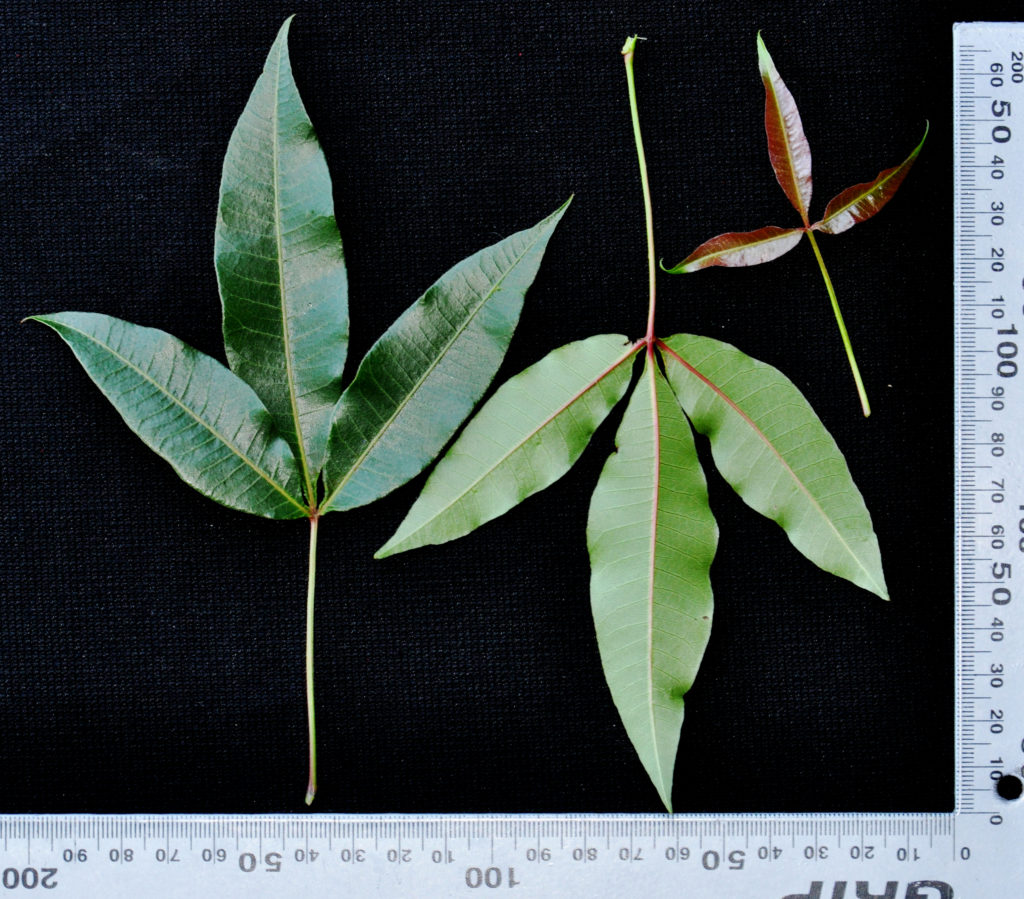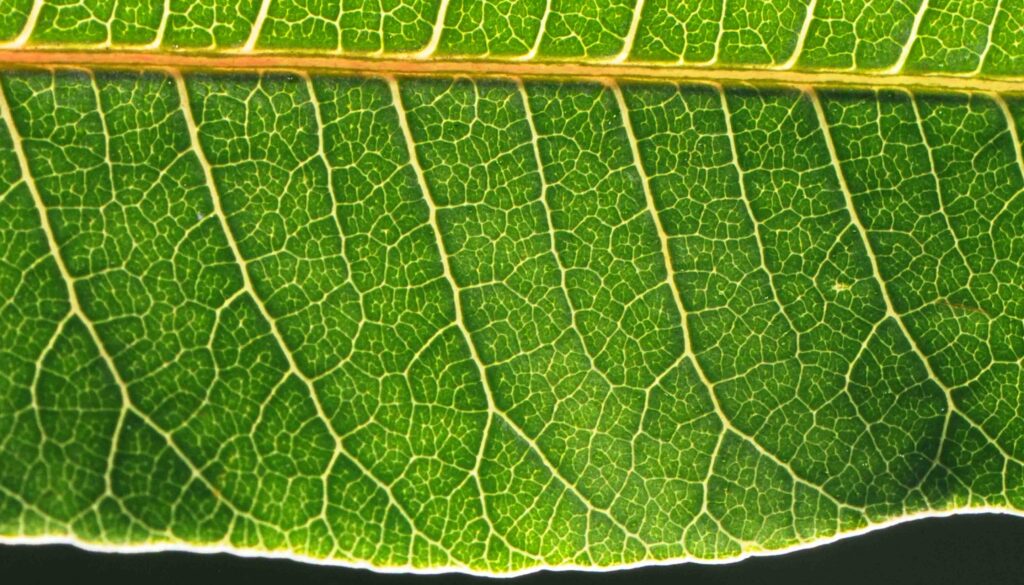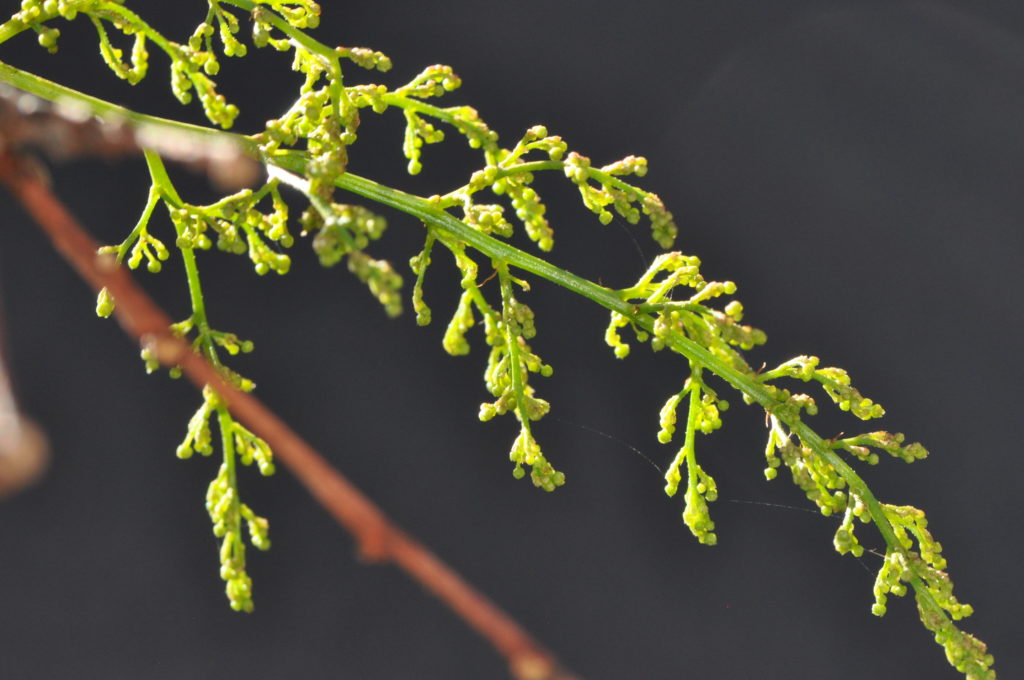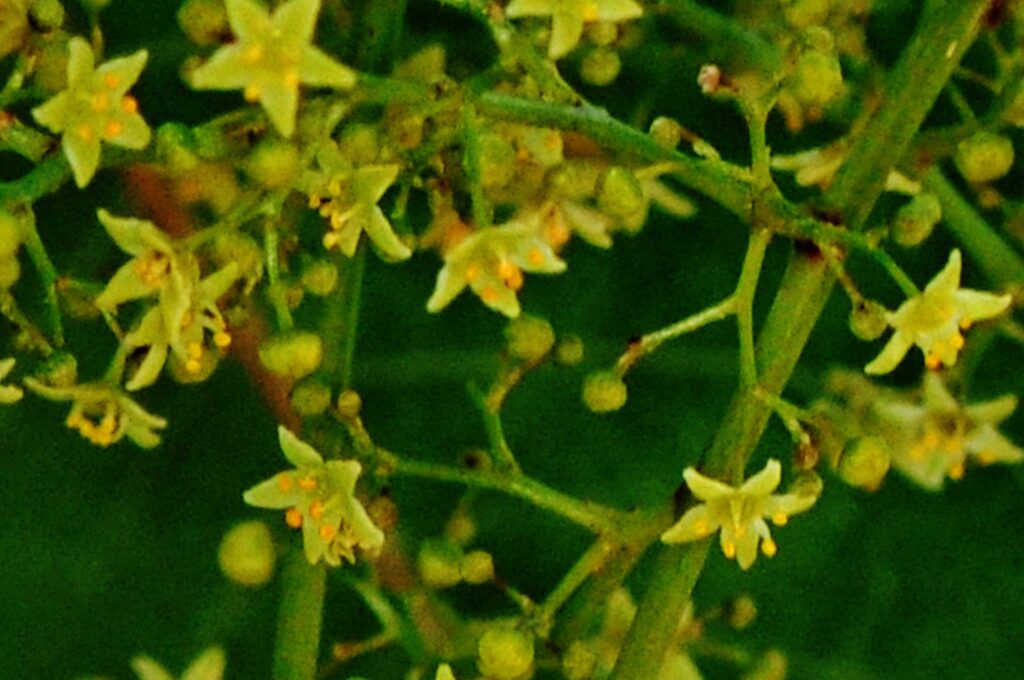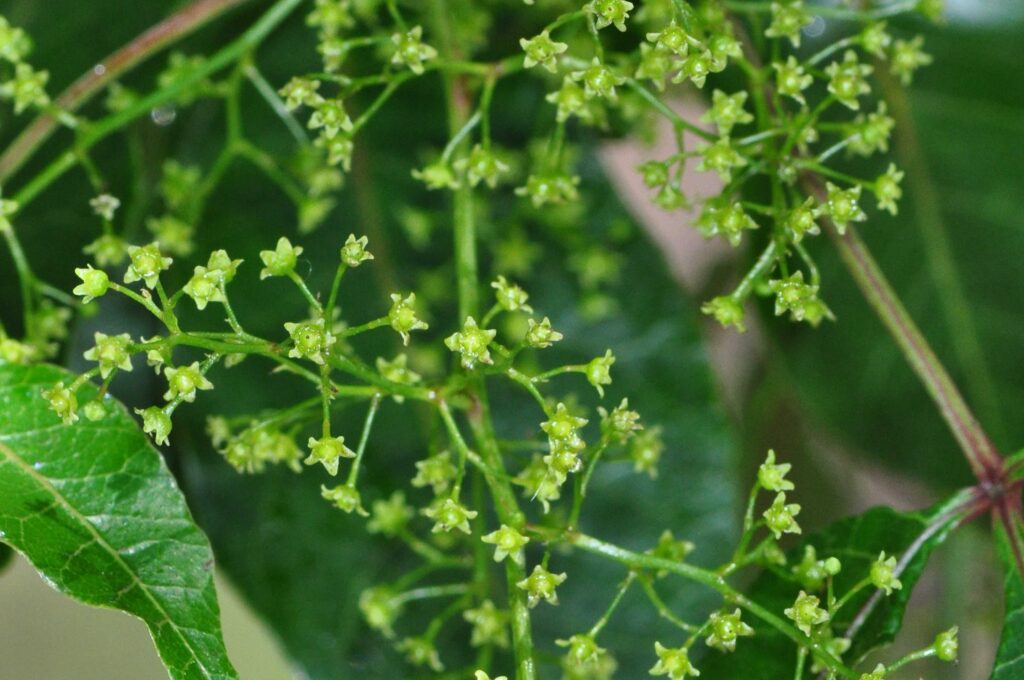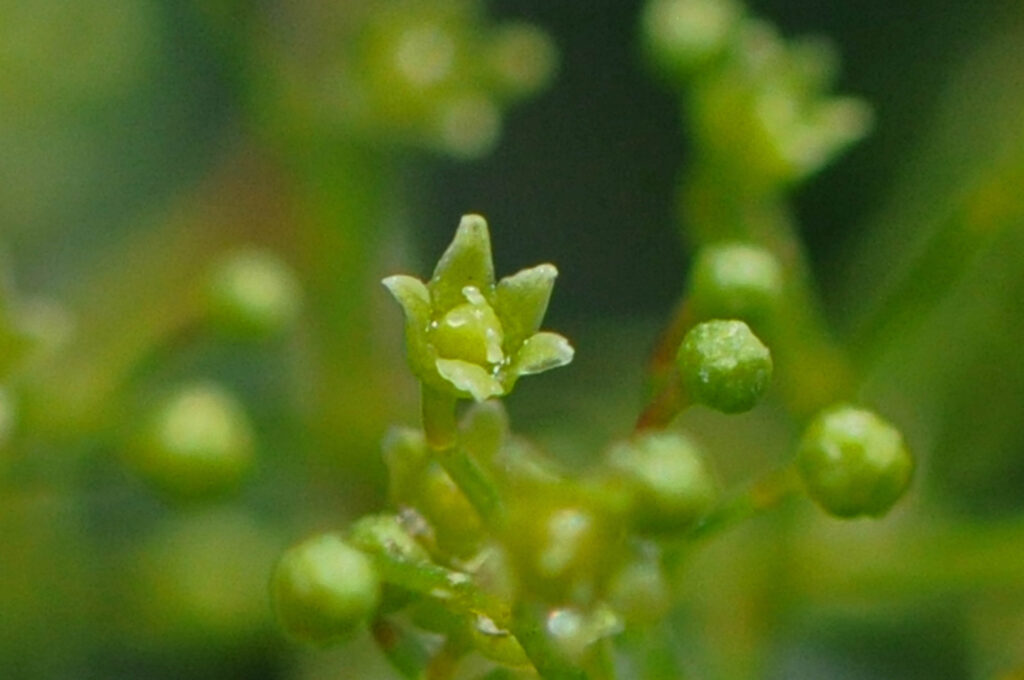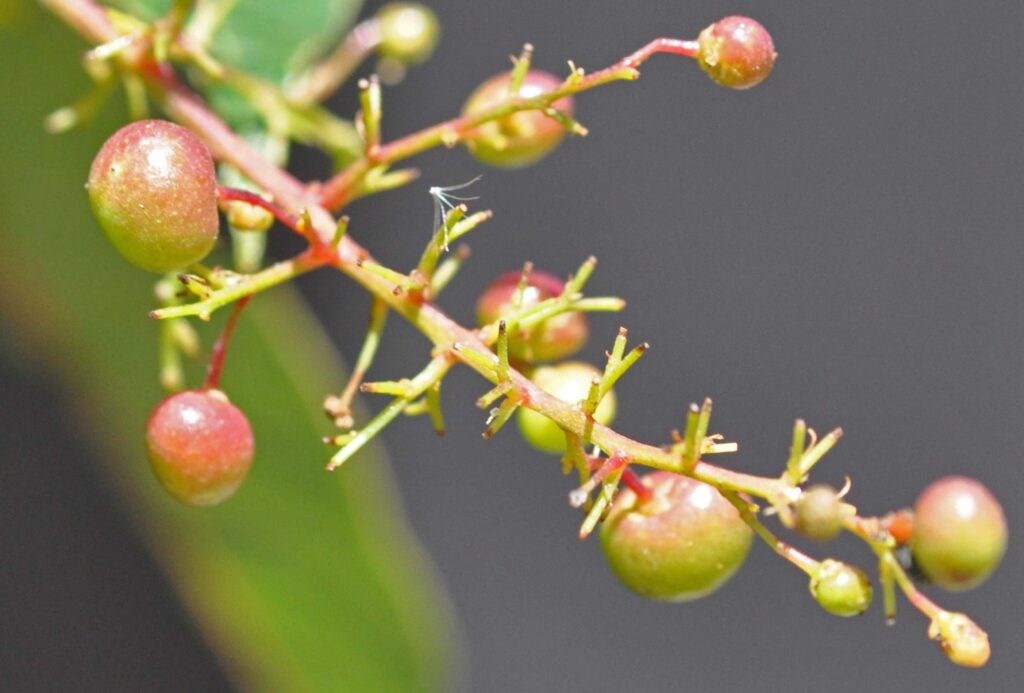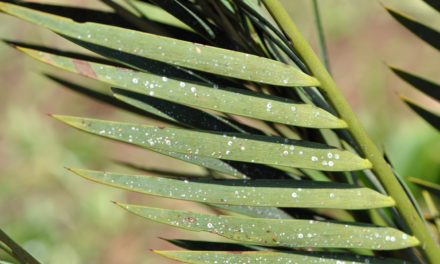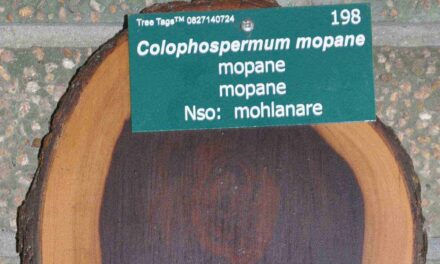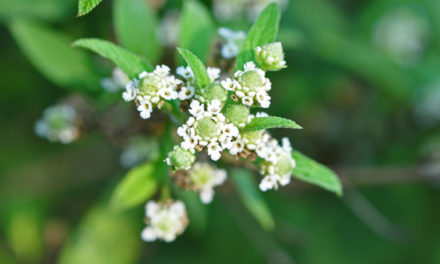General Info – summary
These dioecious and semi deciduous shrubs or erect Trees may reach 25m high – usually much less. A cut stem may yield blood red sap. Trunk is up to 1,3m wide. Trifoliate Leaves have large initially reddish leaflets. Tiny, 5-merous, regular Flowers develop in panicles. Male: 5 anthers, Female 5 staminodes, single pistil + superior ovary and 3 styles. The small, shiny, spherical Fruit is a thinly fleshy edible drupe.
Description
Searsia chirindensis
SA Tree No. 380.
Previous Names: Rhus acuminata, Rhus chirindensis, Rhus laevigata, Rhus legatii, Searsia legatii.
Common names: (Afr) Bosganna, Bostaaibos, Rooitaaibos, Westelike-essenhout. (Eng) Red Currant. (isiXhosa) Umhlakothi omkhulu, Intlokotshane-enkulu, incakotshi. (isiZulu) Ikhathabane, Inhlokoshiyane-enkulu, Umhlabamvubu, Umdwendwelengcuba. (Northern Sotho), Motha-thaa, Mpatha-Kgogo. (siSwati) Inhlangushane. (Tshivenda) Muvhadelaphanga.
Family: Anacardiaceae. (Mango family), which has about 83 genera and 850+ species – including Cashew). About 80 species occur in South Africa. Hunting arrows have been made from straight stems. Resin canals are present and woolly stellate hairs cover all young parts. Leaves lack stipules. They may be deciduous or evergreen and usually alternate. Leaves are simple, trifoliate or digitally compound and imparipinnate. Leaflets are usually opposite. Crushed leaves may smell of turpentine. Trees are monoecious or dioecious with occasional bisexual Flowers. Flowers are small, greenish or yellowish white and usually regular. The Calyx has 4-7 sepals and there are 4-7 Petals. The number of Stamens is the same as, or twice the number of petals and the Anthers are versatile. The superior Ovary has up to 4 locules, each with a single ovule. The 1-5 Styles are free or connate and separated at the base. Fruit is usually an indehiscent fleshy drupe that provide food in dry areas. They contain a single quick growing Seed. The southern Africa genera containing trees on this website include Harpephyllum, Lannea, Loxostylis, Ozoroa, Sclerocarya and Searsia.
Name derivation: Searsia: Named after Paul Bigelow Sears a highly qualified American ecologist (December 17, 1891 – April 30, 1990). He pioneered the study of fossil pollen in the USA. chirindensis – of the Chirinda Forest in Zimbabwe: named by Swynnerton from a specimen he collected in 1906. There are many species of the genus Searsia in southern Africa. DNA research has confirmed difference between the European Rhus and our Searsia.
Conservation: National Status: L C. (Least Concern). Assessed: 2018 (L. von Staden).
Tree
This is the largest member of the genus Searsia in southern Africa. When growing in the open, the Tree has a spreading crown (photo 668). The height is usually 3-4m but may reach 25m or more in Zimbabwe. It may be a multi-stemmed shrub (photo 449). The erect Trunk has a diameter of up to 1,3m and the initially brown smooth Bark becomes grey, rough and darkens with age (photo 16). Young stems and recently cut shoots may exude a deep red sap. Young branches have distinctive Lenticels (a usually raised corky oval or elongated area on the plant that allows the uncontrolled interchange of gases with the environment – photos 16 & 99). Young and coppice branches may have spines, but mature branches are spineless. (Coppice growth. When stems are cut or burned, it causes regrowth from the stump or roots).
- 668. 2014/11/18. Walter Sisulu NBG. Photo: David Becking.
- 449. 2016/11/08. Pretoria NBG. Photo: David Becking.
- 16. 2014/04/29. Walter Sisulu NBG. Photo: David Becking.
- 99. 2014/09/03. Walter Sisulu NBG. Photo: David Becking.
Leaves
The trifoliate (compound leaves with 3 leaflets) Leaves are usually hairless. The tree is usually briefly deciduous, and leaves may turn reddish before falling. Leaves are up to 20cm long. Young leaves are reddish (photos 1019 & 981) and become glossy dark green above when mature (photo 981). The lower side is a lighter green. Mature Leaflets are large and the middle one is the largest – up to 13 x 5cm. Leaflets are ovate (egg shaped) to lanceolate, narrowing to both ends but more pronounced and pointed near the apex (photo 981). Lateral veins are visible on both sides, but net veining is slightly clearer below. Veins details are best viewed against direct sunlight (Photo 987). In this photo, the lateral veins do make contact with the margins. In the field, a hand lens will help with this. On the upper surface, the Midrib is raised and may be reddish or pink in colour – especially close to the base (photo 981). The Apex may be curved and mucronate (ending abruptly in a short sharp point). The Base is broadly tapering. Margins are usually wavy and entire (with a continuous margin, not in any way indented) but may be minutely serrate and wavy (photo 592). The slender Petiole (leaf stalk) may be reddish and is 4-9cm long. It may be distinctively reddish (photo 981) but is not winged. Leaf blades may bend around the midrib and become reddish before winter (photo 592). The often reddish Petiolules (stalks of leaflet) are very short.
- 1019. 2014/08/19. Walter Sisulu NBG. Photo: David Becking.
- 592. 2014/03/06. Walter Sisulu NBG. Photo: David Becking.
- 592. 2014/03/06. Walter Sisulu NBG. Photo: David Becking.
- 981. 2015/11/24. Walter Sisulu NBG. Photo: David Becking.
- 987. 2015/11/24. Walter Sisulu NBG. Photo: David Becking.
Flowers
The tree is Dioecious (unisexual floral structures with male and female parts on separate plants). The small, actinomorphic (Regular, symmetrical. Flowers are vertically divisible into similar halves by more than 1 plane passing through the axis). Flowers develop in Panicles (indeterminate, branched inflorescence with stalked flowers – photo 99 (2)). They are located in branched axillary and terminal heads – up to 20cm long. Panicles occur near the ends of the branchlets. The individual flowers are minute. They are only conspicuous because of the large numbers (photo 35). Flowers are yellow, yellowish-green, or green. There are 5 Sepals which are joined at the base. The 5 Petals are free.
In the Male flowers, the 5 Stamens have free Filaments. Their Anthers have 2 thecae (pollen sacs) present that dehiscence longitudinally. A rudimentary pistil is present. In the Female flowers, there are usually 5 staminodes (sterile stamens) present and there is a single Pistil (a unit of the Gynoecium, the female element of the flower, composed of the Ovary, Styles and Stigmas). The superior Ovary has 3 carpels (each is one of the foliar units of a compound pistil or ovary) and there are 3 Styles present (photo 138). (Aug-Mar).
- 99 (2). 2014/09/30. Walter Sisulu NBG. Photo: David Becking.
- 955. ♂ 2014/10/14. Walter Sisulu NBG. Photo: David Becking.
- 35 2014.09.30 Walter Sisulu NBG. Photo: David Becking.
- 138. ♀ 2014/09/23. Walter Sisulu NBG. Photo: David Becking.
Fruit
The almost spherical Fruit is a small Drupe (a fleshy, 1-seeded indehiscent fruit with the seed enclosed in a stony endocarp; stone fruit like a peach) which is up to 7mm in diameter and occurs in large groups. These hairless drupes are initially green and turn shiny red when ripe (photo 158). In this photo, the Pedicles (flower stalks) and remains of the calyx are visible. The fruit develops near the ends of branches and the mass of many fruit bends down the branches on which they grow. (Oct-Mar).
- 158. 2014/10/21. Walter Sisulu NBG. Photo: David Becking.
Distribution & Ecology
This tree is plentiful in the moister eastern parts of South Africa, in mountains, coastal and inland forests, forest margins, kloofs and scrubs. It is often located in close to rivers, on rocky hillsides and along the escarpment – up to 2 000m. The tree can be found from Swellendam in the Western Cape, through the Eastern Cape, Kwazulu-Natal and Mpumalanga to Limpopo e.g. Soutpansberg mountains. It also occurs in Swaziland, Mozambique – central west and southern, Zimbabwe and possibly northwards. The tree can tolerate mild frost and is drought resistant. Coppicing is common. Black Rhino eat the Bark and leaves. The bark may contain lichen (composite organism arising from a mutualistic relationship between fungi or cyanobacteria and algae species (top left of photo 16M under Tree). Elephants, including the Knysna elephants, bushbuck, nyala, kudu, and red duiker consume the Leaves. Monkeys, turacos (loeries), bulbuls, barbets, Cape white-eyes, and pigeons eat the Fruit. The fruit juice attracts fruit piercing and sap sucking moths. This plant may Hybridise (crossbreed with individuals of two different species or varieties) e.g. with Searsia dentate.
Ethnobotany
The sweetish, edible Fruit is thinly fleshy (All indigenous Searsia species in South Africa have edible fruit that is rich in carbohydrates). For fruit development, both male and female trees are required. The strong dense Wood makes good furniture. Sapwood is yellowish to reddish and the dense heartwood has an impressive sheen. Research on the possible benefits of this tree on prenatal stress is being carried out at the University of KwaZulu-Natal. Bark extracts may be useful in the treatment of convulsions and epilepsy. Local medicine makes use of the bark. The tree provides valuable fodder in dry areas. It is an attractive shade tree – grown in gardens. This tree is quick growing from seeds or cuttings and the roots are not invasive. Using select male and female cuttings will help in this respect. This is a good shade tree.
References
Boon, R. 2010. Pooley’s Trees of eastern South Africa. Flora and Fauna Publications Trust, Durban.
Burrows, J.E., Burrows, S.M., Lotter, M.C. & Schmidt, E. 2018. Trees and Shrubs Mozambique. Publishing Print Matters (Pty) Ltd. Noordhoek, Cape Town.
Coates Palgrave, M. 2002. Keith Coates Palgrave Trees of Southern Africa. edn 3. Struik, Cape Town.
Ginn P.J. Mcilleron W.G. and Milstein P. le S, 1989. The Complete Book of Southern African Birds. Struik, Cape Town.
Palmer, E. & Pitman, N. 1972. Trees of southern Africa. Balkema, Amsterdam, Cape Town.
Schmidt, S. Lotter, M. & McCleland, W. 2002. Trees and Shrubs of Mpumalanga and the Kruger National Park. Jacana, Johannesburg.
van Wyk, B. & van Wyk, P. 1997 Field guide to Trees of Southern Africa. Struik, Cape Town.
von Staden, L. 2018. Searsia chirindensis (Baker f.) Moffett. National Assessment: Red List of South African Plants version 2020.1. Accessed on 2023/12/01.
http://www.plantzafrica.com/plantqrs/searsiachirind.htm
http://witbos.co.za/plant.aspx?plant=searsia-(rhus)-chirindensis
http://operationwildflower.org.za/index.php/albums/genera/searsias/searsia-chirindensis-red-currant-bostaaibos-il-1-1509
http://www.sciencedirect.com/science/article/pii/S0168010215002230
https://en.wikipedia.org/wiki/Rhus_chirindensis
http://posa.sanbi.org/flora/browse.php?src=SP
https://en.wikipedia.org/wiki/Paul_Sears

